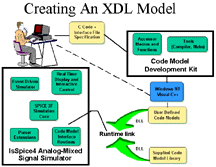
![]()
 |
|
|
|
|
Description: HDL Model Development Kit available from Intusoft
Requirements: Microsoft Visual C++ (Free Download from Microsoft)
Compatibility: Compiled models run on IsSpice4 under Windows XP through 10
Contacts: e-mail : sales@intusoft.com
|
"Intusoft Introduces
SDK for First Publicly Available HDL" |
 |
Intusoft has introduced support tools for
a new non-proprietary HDL (Hardware Description Language). The
support comes in two forms. A new Code Model Software Development
Kit, or CMSDK, has been introduced to allow designers to develop
and debug HDL models for use with IsSpice4 . Secondly, the companies'
SPICE 3 simulator, IsSpice4 , now includes simulator enhancements
and support for models written using the HDL. Copyright Intusoft 2020, All Rights Reserved.
The HDL modeling architecture is based on the publicly available
Unix based XSPICE program, distributed by the Georgia Tech Research
Corporation, a unit of the Georgia Institute of Technology. The
HDL is called XDL (eXtended Description Language) and it differs
from current AHDL offerings which are proprietary in nature and
only work with Unix based simulators. XDL is based on the C programming
language and is the only non-proprietary analog and mixed signal
HDL available for Windows. It represents a new and powerful approach
to making simulation models and interfaces.
The Intusoft CMSDK provides a major breakthrough in HDL technology
in terms of power and affordability. It allows the designer to
add new analog, digital, or mixed analog/digital models to IsSpice4
very easily. Adding a model to SPICE in the traditional manner
can take several months. The Intusoft CMSDK cuts this time to
days or even hours. XDL modeling is also called "Code Modeling"
because models are developed using C subroutines. The use of a
standard programming language like C greatly lessens the learning
curve since users do not have to learn a proprietary language
or use unfamiliar tools. When coupled with IsSpice4 's behavioral
modeling features, the XDL modeling capability completes the AHDL
picture for IsSpice4 giving it all the features and portability
of even the most powerful modeling languages at a cost far below
any existing solution.
What Can You Do
With XDL?
XDL models open many areas of simulation to SPICE users that were
formally closed because of the complexities of modeling or the
inefficiency of behavioral models. Designers can now efficiently
simulate system and board level designs containing mixed mode
circuits, sample data systems, and mixed domain (electrical-physical)
descriptions, using a top-down simulation methodology. XDL models
may be as simple as a gain block or as complex as a new MOSFET
model. They can perform virtually any function, analog or digital,
with any level of accuracy. XDL also accepts a user defined data
type allowing non-electrical systems and processes to be simulated.
Unfortunately, currently available AHDL products are targeted
mainly at device modeling. This is not the case with XDL and to
think of XDL as only a device modeling language would severely
limits its potential. XDL provides hooks into the SPICE simulation
engine. And since models are written in C the user has access
to the operating system. This allows XDL to interface SPICE to
other simulators, other software utilities, or even directly to
hardware. XDL is simply not restricted to device modeling like
other AHDLs.
Once created, XDL models behave exactly like traditional SPICE
models. They become an extension of the standard devices offered
in IsSpice4 and are accessed in the same manner as a diode or
BJT. The XDL (C source) can be used with any simulator that understands
the XSPICE extensions. The CM-SDK also offers special provisions
for converting existing SPICE models to XDL code. Table 1 describes
some of the major benefits of using XDL, the Intusoft CM-SDK,
and IsSpice4.